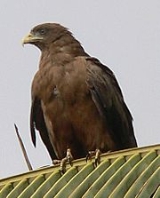
Yellow-billed Kite
Encyclopedia
The Yellow-billed Kite (Milvus aegyptius) is the Afrotropic counterpart of the Black Kite
(Milvus migrans), of which it is most often considered a subspecies
. However, recent DNA
studies suggest that the Yellow-billed Kite differs significantly from Black Kites in the Eurasia
n clade
, and should be considered as a separate, allopatric species.
There are two subspecies: M. a. parasitus, found throughout most of sub-Saharan Africa
(including Madagascar
), except for the Congo Basin
(with intra-African migrations) and M. a. aegyptius of Egypt
, south-west Arabia and the Horn of Africa
(which disperses south during the non-breeding season).
(which is present in Africa as a visitor during the North Hemisphere
winter). However, immature Yellow-billed Kites resemble the corresponding age of the Black Kite.
July–March and sometimes as late as May. It is generally common.
. They feed on a wide range of small vertebrates and insects, much of which is scavenged.
Black Kite
The Black Kite is a medium-sized bird of prey in the family Accipitridae, which also includes many other diurnal raptors. Unlike others of the group, they are opportunistic hunters and are more likely to scavenge. They spend a lot of time soaring and gliding in thermals in search of food. Their...
(Milvus migrans), of which it is most often considered a subspecies
Subspecies
Subspecies in biological classification, is either a taxonomic rank subordinate to species, ora taxonomic unit in that rank . A subspecies cannot be recognized in isolation: a species will either be recognized as having no subspecies at all or two or more, never just one...
. However, recent DNA
DNA
Deoxyribonucleic acid is a nucleic acid that contains the genetic instructions used in the development and functioning of all known living organisms . The DNA segments that carry this genetic information are called genes, but other DNA sequences have structural purposes, or are involved in...
studies suggest that the Yellow-billed Kite differs significantly from Black Kites in the Eurasia
Eurasia
Eurasia is a continent or supercontinent comprising the traditional continents of Europe and Asia ; covering about 52,990,000 km2 or about 10.6% of the Earth's surface located primarily in the eastern and northern hemispheres...
n clade
Clade
A clade is a group consisting of a species and all its descendants. In the terms of biological systematics, a clade is a single "branch" on the "tree of life". The idea that such a "natural group" of organisms should be grouped together and given a taxonomic name is central to biological...
, and should be considered as a separate, allopatric species.
There are two subspecies: M. a. parasitus, found throughout most of sub-Saharan Africa
Sub-Saharan Africa
Sub-Saharan Africa as a geographical term refers to the area of the African continent which lies south of the Sahara. A political definition of Sub-Saharan Africa, instead, covers all African countries which are fully or partially located south of the Sahara...
(including Madagascar
Madagascar
The Republic of Madagascar is an island country located in the Indian Ocean off the southeastern coast of Africa...
), except for the Congo Basin
Congo Basin
The Congo Basin is the sedimentary basin that is the drainage of the Congo River of west equatorial Africa. The basin begins in the highlands of the East African Rift system with input from the Chambeshi River, the Uele and Ubangi Rivers in the upper reaches and the Lualaba River draining wetlands...
(with intra-African migrations) and M. a. aegyptius of Egypt
Egypt
Egypt , officially the Arab Republic of Egypt, Arabic: , is a country mainly in North Africa, with the Sinai Peninsula forming a land bridge in Southwest Asia. Egypt is thus a transcontinental country, and a major power in Africa, the Mediterranean Basin, the Middle East and the Muslim world...
, south-west Arabia and the Horn of Africa
Horn of Africa
The Horn of Africa is a peninsula in East Africa that juts hundreds of kilometers into the Arabian Sea and lies along the southern side of the Gulf of Aden. It is the easternmost projection of the African continent...
(which disperses south during the non-breeding season).
Description
As suggested by its name, the Yellow-billed Kite is easily recognized by its entirely yellow bill, unlike that of the Black KiteBlack Kite
The Black Kite is a medium-sized bird of prey in the family Accipitridae, which also includes many other diurnal raptors. Unlike others of the group, they are opportunistic hunters and are more likely to scavenge. They spend a lot of time soaring and gliding in thermals in search of food. Their...
(which is present in Africa as a visitor during the North Hemisphere
Northern Hemisphere
The Northern Hemisphere is the half of a planet that is north of its equator—the word hemisphere literally means “half sphere”. It is also that half of the celestial sphere north of the celestial equator...
winter). However, immature Yellow-billed Kites resemble the corresponding age of the Black Kite.
Status
It is mostly an intra-African breeding migrant, present in Southern AfricaSouthern Africa
Southern Africa is the southernmost region of the African continent, variably defined by geography or geopolitics. Within the region are numerous territories, including the Republic of South Africa ; nowadays, the simpler term South Africa is generally reserved for the country in English.-UN...
July–March and sometimes as late as May. It is generally common.
Habitat and feeding
They are found in almost all habitats, including parks in suburbia, but rare in the arid Namib and KarooKaroo
The Karoo is a semi-desert region of South Africa. It has two main sub-regions - the Great Karoo in the north and the Little Karoo in the south. The 'High' Karoo is one of the distinct physiographic provinces of the larger South African Platform division.-Great Karoo:The Great Karoo has an area of...
. They feed on a wide range of small vertebrates and insects, much of which is scavenged.

